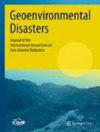通过 iSUMM 评估地下洞穴的稳定性(创新、直接、用户友好、基于力学的方法)
IF 4
Q2 ENVIRONMENTAL SCIENCES
引用次数: 0
摘要
意大利不同的城市地区记录了大量的天坑事件,其发生频率在过去几十年中大幅上升,有时甚至造成人员伤亡。发生此类灾难性事件的主要原因是几十年前在松软岩石中挖掘出的人工地下洞穴的存在,这些洞穴很浅,随后被废弃。在这种情况下,与上覆建筑物和基础设施发生相互作用的可能性以及相应的天坑危险相对较高。在这种情况下,挖掘出空洞的软岩层(如意大利南部大面积出露的方解石岩层)的机械性能较低,且极易受到风化过程的影响,是导致不稳定的最重要诱因之一。因此,评估地下空洞的稳定性对于土地管理和规划至关重要。Perrotti 等人开发的基于力学的稳定性图表(Int J Geomech 18(7):04018071,2018 年)已被证明是初步稳定性评估的有效工具,虽然可以确定洞穴最终的不稳定性,但并不能对安全系数本身进行量化评估。在这方面,本研究旨在介绍该方法开发过程中取得的最新成果,并旨在推广一种更好的应用方法,从而使该图表成为世界类似地区天坑危险初步评估的实用工具。本文章由计算机程序翻译,如有差异,请以英文原文为准。
Assessing the stability of underground caves through iSUMM (innovative, straightforward, user-friendly, mechanically-based method)
A huge number of sinkhole events has been recorded in different Italian urban areas, with an occurrence frequency largely increasing in the last decades, sometimes even causing loss of human lives. The main reason for such catastrophic events is the presence of man-made underground cavities, excavated within soft rocks, several decades ago and then abandoned, at shallow depths. Here, the possibility of interaction with overlying buildings and infrastructures and the corresponding sinkhole hazard is relatively high. In such contexts, the low mechanical properties of the soft rock formations where the cavities have been excavated, like those formed of calcarenites, which outcrop in large areas of Southern Italy, and their high susceptibility to weathering processes, represent one of the most important predisposing factors for instability. Therefore, assessing the stability of underground cavities is crucial for land management and planning purposes. The mechanically-based stability charts developed by Perrotti et al. (Int J Geomech 18(7):04018071, 2018) have proved to be a valid tool for preliminary stability assessment and, although allow to identify an eventual proneness of the cave to instability, they do not provide quantitative assessment about the safety margin itself. In that regard, this study intends to present the most recent outcomes obtained in the development of the methodology and is aimed at promoting an enhanced way for their application, so that the charts can become an operative tool for preliminary sinkhole hazard assessment in similar regions in the world.
求助全文
通过发布文献求助,成功后即可免费获取论文全文。
去求助
来源期刊

Geoenvironmental Disasters
Social Sciences-Geography, Planning and Development
CiteScore
8.90
自引率
6.20%
发文量
22
期刊介绍:
Geoenvironmental Disasters is an international journal with a focus on multi-disciplinary applied and fundamental research and the effects and impacts on infrastructure, society and the environment of geoenvironmental disasters triggered by various types of geo-hazards (e.g. earthquakes, volcanic activity, landslides, tsunamis, intensive erosion and hydro-meteorological events).
The integrated study of Geoenvironmental Disasters is an emerging and composite field of research interfacing with areas traditionally within civil engineering, earth sciences, atmospheric sciences and the life sciences. It centers on the interactions within and between the Earth''s ground, air and water environments, all of which are affected by climate, geological, morphological and anthropological processes; and biological and ecological cycles. Disasters are dynamic forces which can change the Earth pervasively, rapidly, or abruptly, and which can generate lasting effects on the natural and built environments.
The journal publishes research papers, case studies and quick reports of recent geoenvironmental disasters, review papers and technical reports of various geoenvironmental disaster-related case studies. The focus on case studies and quick reports of recent geoenvironmental disasters helps to advance the practical understanding of geoenvironmental disasters and to inform future research priorities; they are a major component of the journal. The journal aims for the rapid publication of research papers at a high scientific level. The journal welcomes proposals for special issues reflecting the trends in geoenvironmental disaster reduction and monothematic issues. Researchers and practitioners are encouraged to submit original, unpublished contributions.
 求助内容:
求助内容: 应助结果提醒方式:
应助结果提醒方式:


